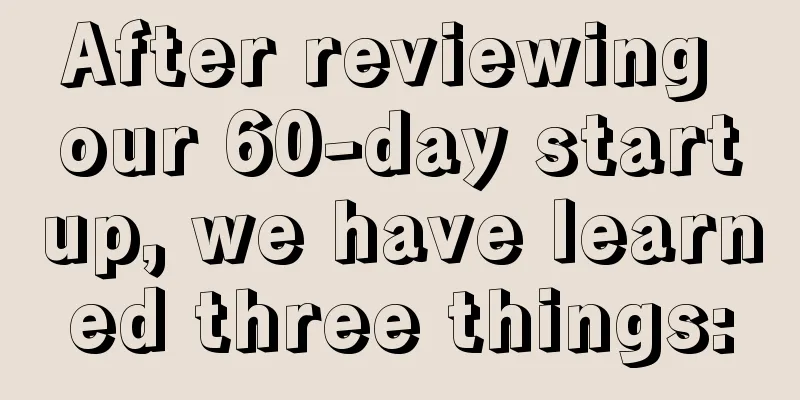A large company: 5 golden rules for user analysis

I was chatting with a friend from a large company at the weekend and we talked about user analysis. Many companies do user analysis, but many people’s user analysis is superficial. They just count the number of active days, online time, and cumulative consumption of users, and then start staring at the numbers, not knowing how to make in-depth insights. After discussing with my friends, I summarized the 5 golden rules of user analysis, which can effectively solve the problem of "staring at indicators in a daze". Let's take a look. 1. Rule 1: Start with user segmentationAs the saying goes: Long sleeves make good dancing, and more money makes good business. When doing data analysis, if the data itself is very small, it is difficult to analyze in-depth conclusions. Reflected in user analysis, if the user is a light user, who only leaves a mobile phone number when registering and logs in once or twice and then never comes back, there is definitely no data to analyze. Only heavy users with a lot of accumulated data can make in-depth interpretations. Therefore, if you want to make the user analysis more in-depth, you must first stratify and distinguish between light, medium, and heavy users, and then look at:
This way, you can see the reason and avoid counting a bunch of averages such as average monthly consumption and average monthly online time, which will erase the differences between users. For specific methods of user segmentation, you can refer to: This is the real user segmentation, not looking at averages. 2. Rule 2: Indicators are divided into deep and shallow, and the content depends on the needsAfter completing the first step, many people naturally think: I see that heavy users log in 7 days a week, and light users log in 1 day a week, so I organize a check-in activity to get light users to log in 7 days. This idea is outrageous. Just imagine, when we use the app, do we seriously calculate the time and clicks when we log in? Unless I am trying to get the opening reward, no one would think so. The user's login, activity, and consumption behavior all have specific goals. Here is the content I like, here are the products I like, and here are the rewards. These are the intuitive reasons. And these reasons need to be obtained by labeling the content and products. In principle, the more behaviors (consumption, interaction) a user accumulates under a tag, the more demand the user has for the content/product under that tag. Based on this, when we want to promote a product, we should try it several times to expose the product to users so that we can accumulate data and make reasonable inferences (as shown in the figure below). Rule 3: Combine testing and miningAfter completing the first step, many people will naturally think of analyzing how heavy users evolved from light users step by step, summarizing the experience, and copying it to other light users. This is a good idea, but it may not work, because the products and services that a company can provide to users are limited and can only attract specific users, so light and heavy users are not necessarily the same type of people. Therefore, through the consumption/interaction process of heavy users, a growth path can be summarized in theory:
BUT, this approach may not be useful for all light users, so it may be necessary to develop several more test lines and stimulate light users through different means to see which one works. There is a classic problem here: many people expect to use data to calculate an optimal recommendation rule to activate light users immediately. This is difficult because light users often have very little data accumulation, and it is difficult to draw effective conclusions in the absence of testing. Therefore, it is strongly recommended to do more testing and collect some data first. Moreover, operations are not without data analysis. There are many conventional/general recommendation logics that can be used (as shown in the figure below). For example, if a user buys beer, we should recommend diapers to him, right? No! If he really buys beer, there are too many things that are more suitable than diapers, such as:
These products are naturally related to each other and can be recommended without data. Therefore, we can first determine the test route based on these natural rules, and then continue to recommend information to stimulate users and see which one they will respond to. This not only accumulates data and lays the foundation for continuous insight into users, but also accumulates experience and quickly improves performance. 4. Rule 4: Try more and accumulate continuouslyIt is not enough to only look at static data when doing user analysis, especially for light users/churned users. The existing data is too little, and subsequent behavior is all guesswork, so it is difficult to draw conclusions. Therefore, we can combine the existing product situation of our company + operating budget to formulate a route to increase users, and then test the effects one by one, while accumulating experience. The best case scenario is that through testing, a new path can be found to promote the conversion of light users to heavy users, which is a great achievement. Of course, in the worst case, it is found that under the existing conditions, the combination of products + discounts + content that can be tried has been exhausted and still cannot be done well. This is actually also valuable. Knowing that the existing means are not working, at least it can save some resources and promote the upgrade of underlying capabilities such as product upgrades/optimized operation methods. Many companies here will have problems in operation:
Often, the operations/product departments of these companies like to boast that "we are the ones who can defeat the master with random punches" and like to shout: "The purpose of activities is to generate benefits!" and "Don't do it if you are not absolutely sure!" The result is that either there is no data at all and they never know what users like, or the data is polluted and new products are almost entirely dependent on promotions, with no additional conclusions other than "our users love to get bargains." Data analysis is not about taking one step and predicting the next 100 steps. It is about checking every step you take: whether there is any deviation, whether you are moving fast enough, and whether you can achieve your expectations. This is something you must remember. Rule 5: Discuss the effect of profit-driven separatelyThere is a situation that needs to be discussed separately, that is: the user is driven by interests and completes XX behavior. Common ones, such as:
In particular, when the goods subsidized by our company are:
This will trigger a large number of users to be active and spend a lot in the short term, but in the long run, these users have not established trust in our company and are simply looking for cheap products. The data generated by this profit-driven approach will interfere with the judgment of normal user needs, resulting in inaccurate subsequent judgments. Therefore, interest-driven behaviors must be individually identified and analyzed:
This can effectively identify who has been bribed, and the rest are likely to be users with real needs. Author: Down-to-earth Teacher Chen Source: WeChat public account "Down-to-earth Teacher Chen (ID: gh_abf29df6ada8)" |
>>: How did “Zibo BBQ” become popular?
Recommend
How much does it cost to sell on Amazon? How much do I need to prepare?
It is relatively simple to open a store on Amazon....
Amazon US UPS return service extended to November 1
Amazon US announced that Amazon recently launched ...
DeepSeek advanced gameplay: mass production of popular content
How to further improve content creation efficiency...
How to apply for an eBay sub-account? What is the method?
There are actually quite a lot of merchants engage...
Why do young people on Xiaohongshu and Douyin flock to ski resorts?
With the arrival of winter, skiing, once considere...
Can I register again after cancelling my account on Shopee? Is it still worth doing?
If sellers want to develop the Southeast Asian mar...
How can I get a second review for my Shopee store? How long does it take to pass the second review?
If you choose to settle in Shopee, you need to sub...
The blind box economy beyond the blind box hides the fanatical code of young people
In recent years, more and more blind box concept p...
MINISO, addicted to collaborations, has turned itself into a "toy store"
As the retail industry continues to change, MINISO...
Can Amazon Middle East do self-delivery? How to do it?
Amazon Middle East Station supports Amazon FBA and...
Douyin no longer accompanies Xiao Yangge's "madness"
As the dividends of live-streaming e-commerce have...
Why isn’t your brand marketing working?
In current brand communication, the conversion eff...
Old domestic brands are becoming popular again, and "Vigor 28" cannot rely solely on "overwhelming traffic"
This article discusses how the time-honored Chines...
Paying for knowledge is compound interest, but it should not be huge profits!
Knowledge payment has been very popular in recent ...
From Jingzhe to Spring Equinox, Banana is one step closer to life
This article reveals how Jiaoxia integrates lightw...









